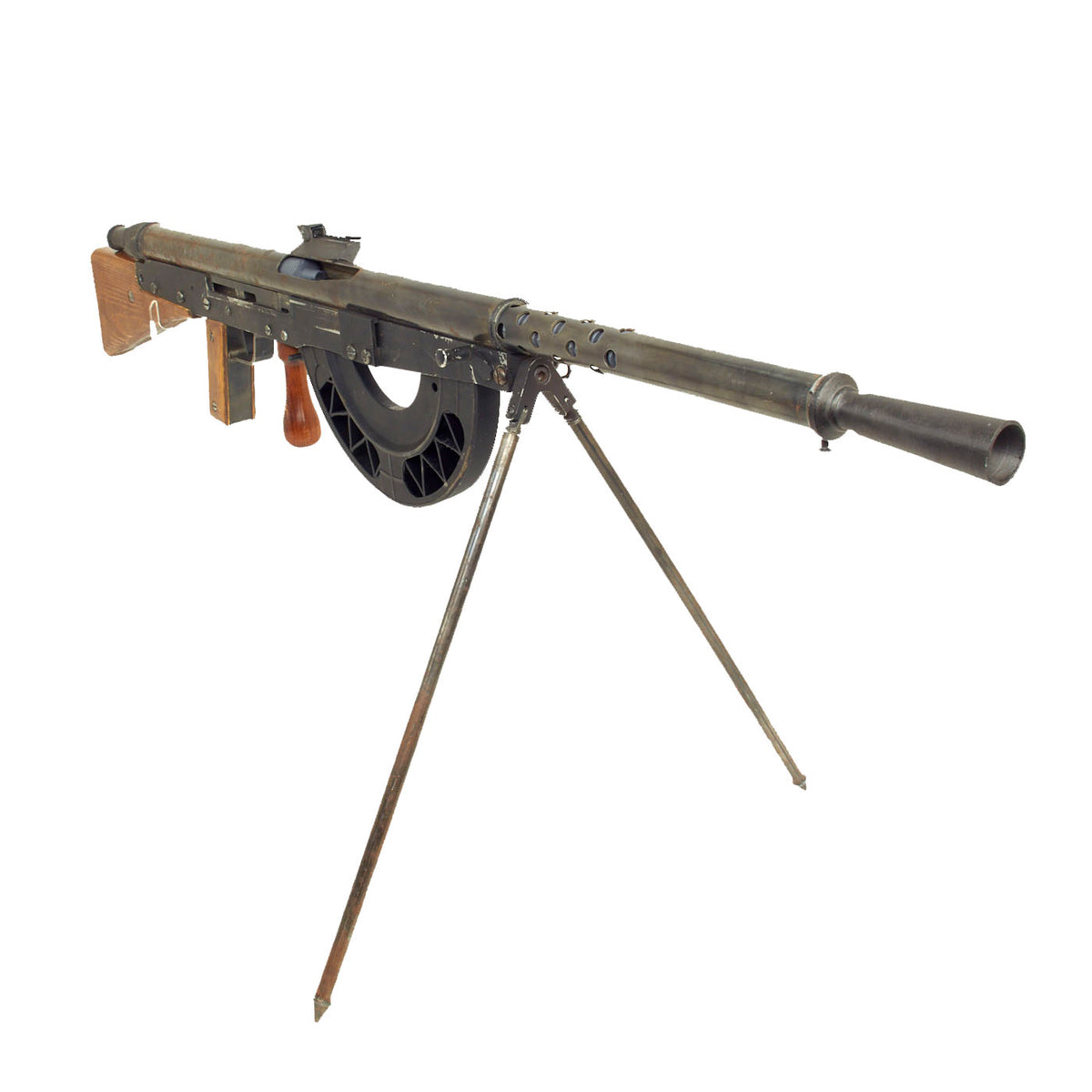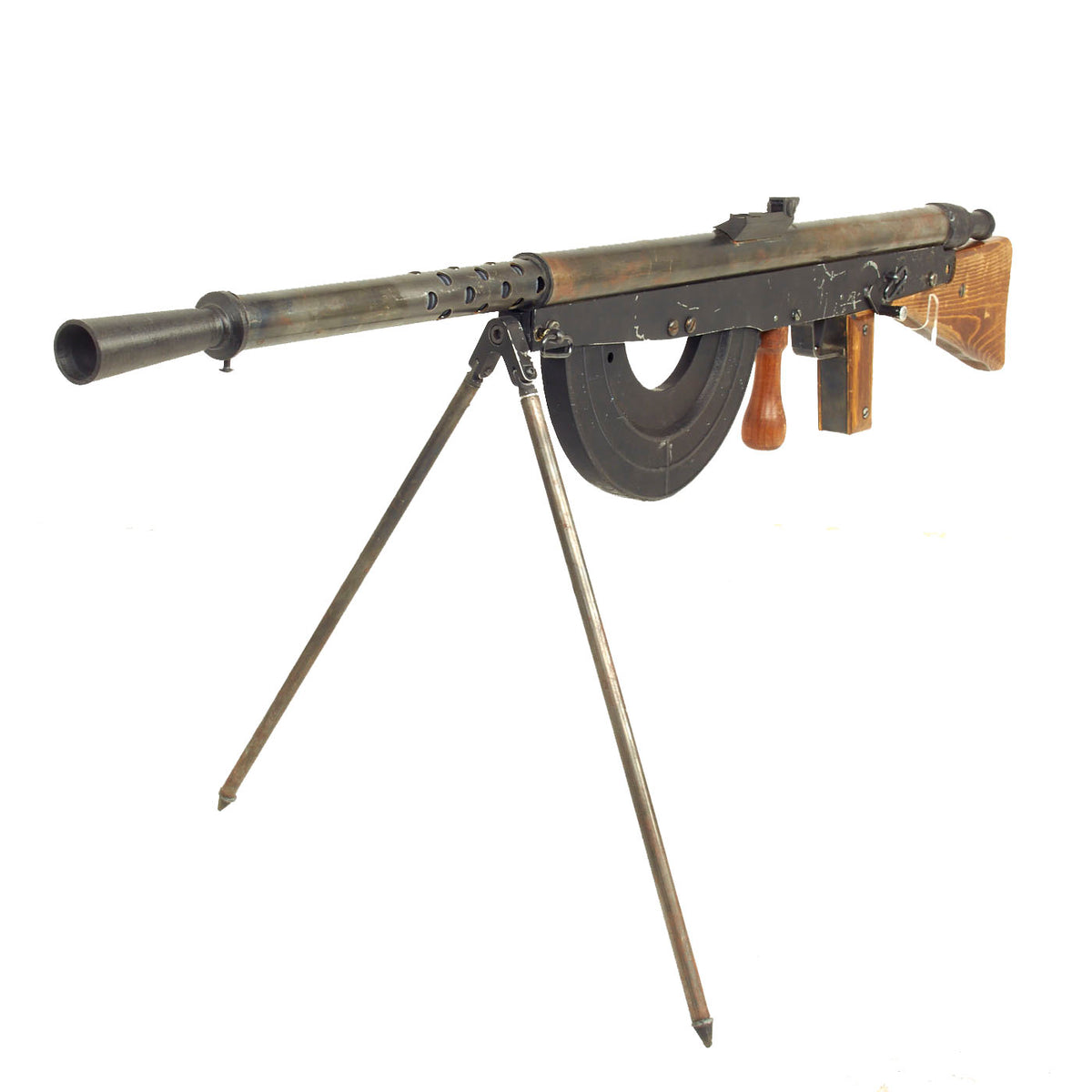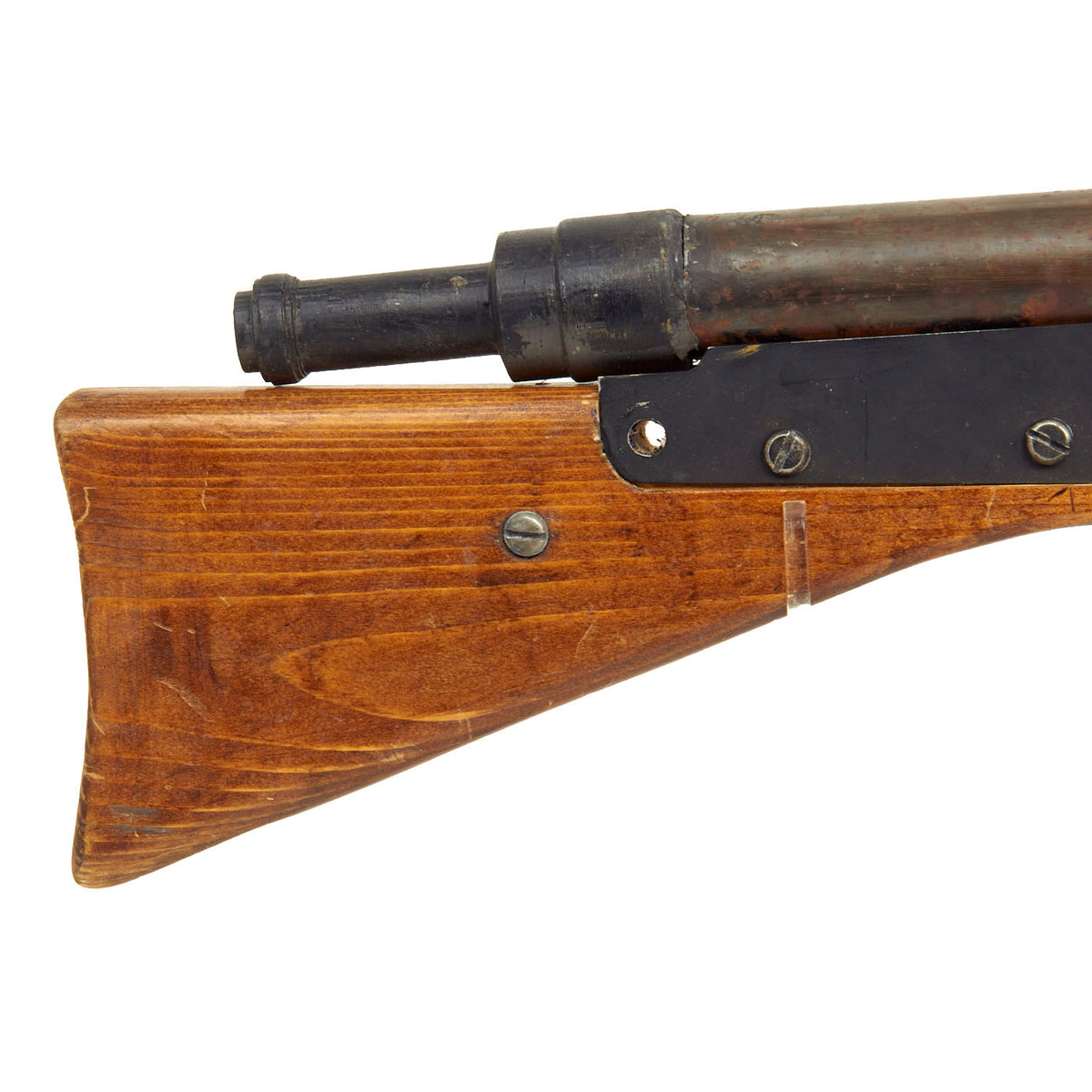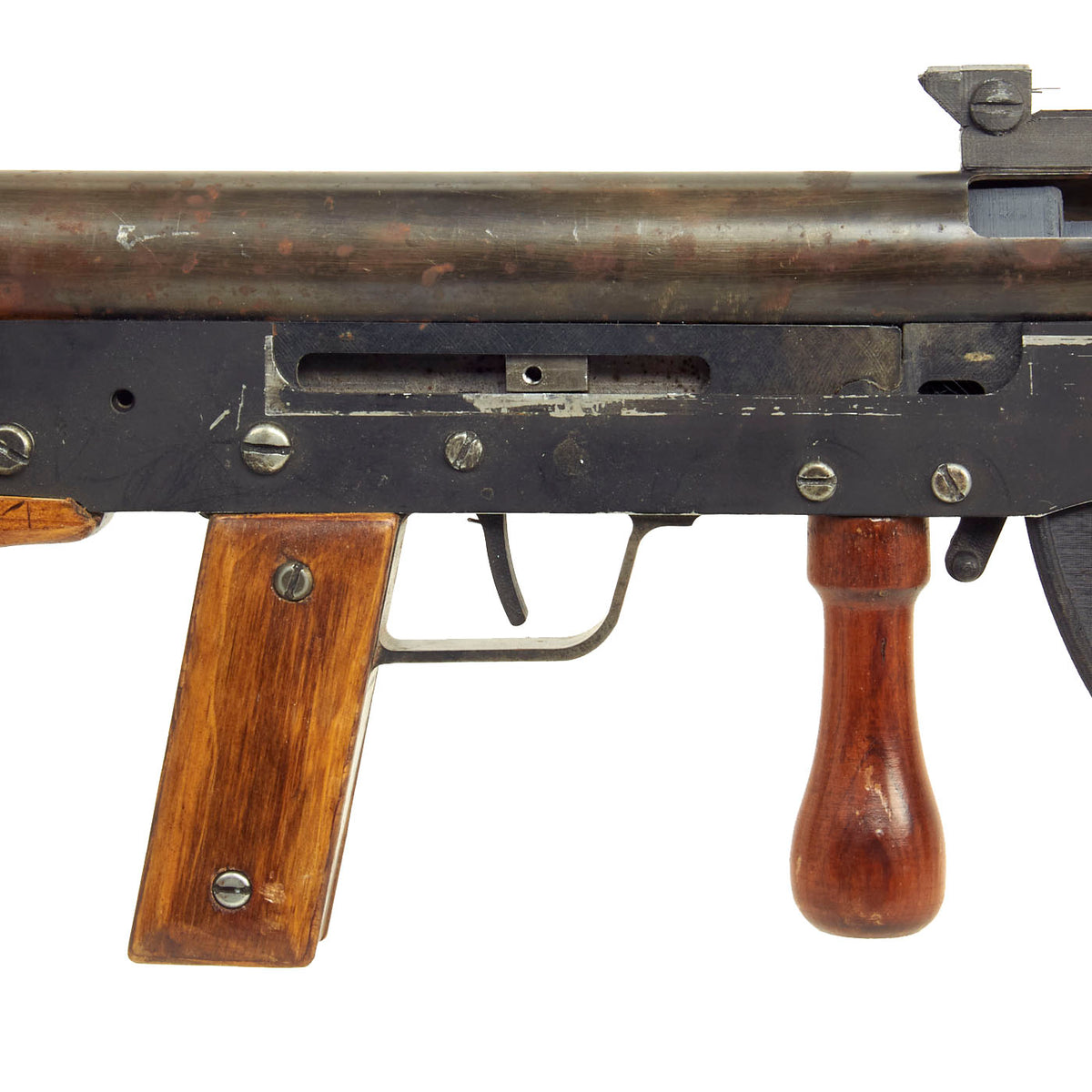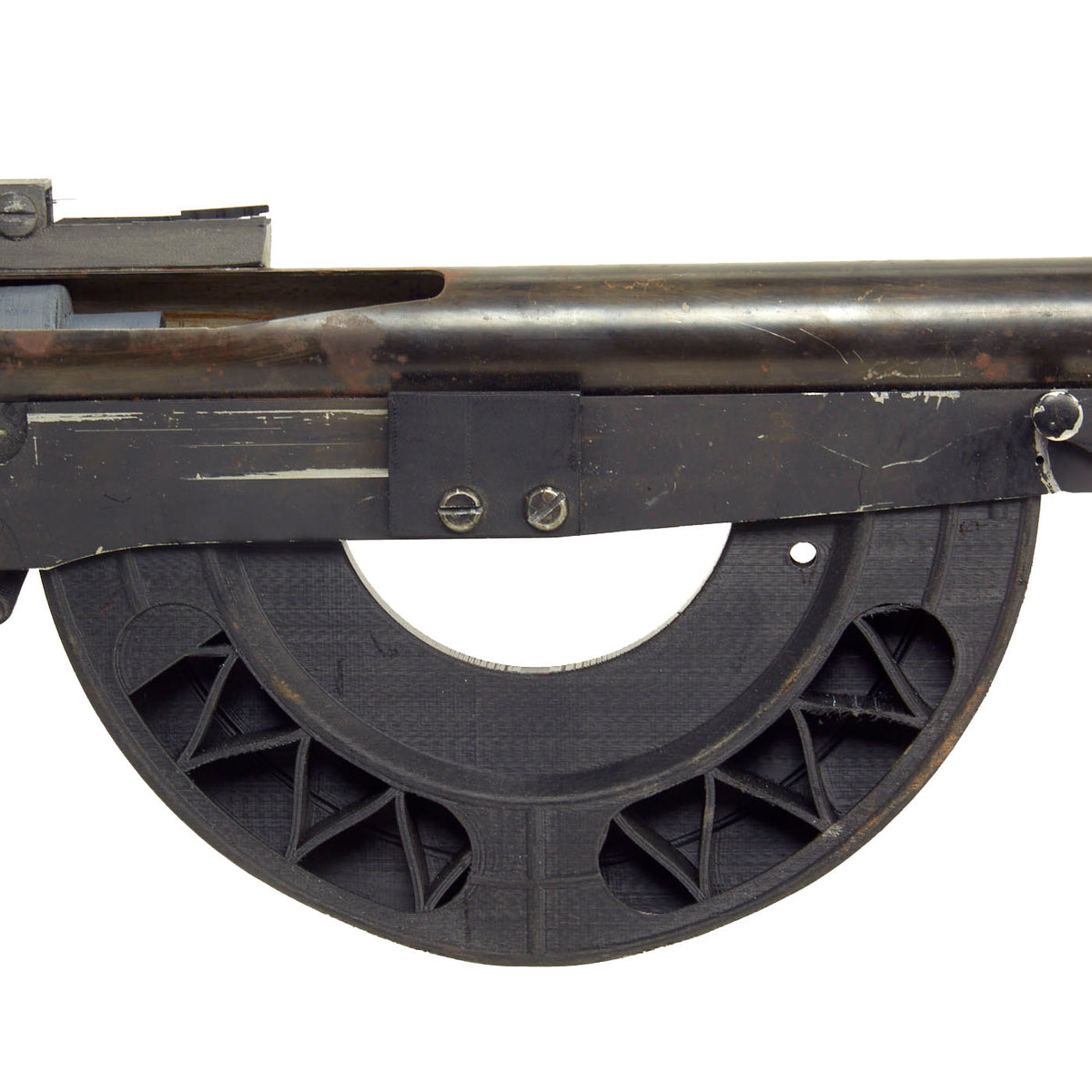Original Film Prop: French WWI Chauchat Light Machine Gun With 3D Printed Components Original Items
$ 695,00 $ 208,50
Only One Available. The Chauchat was the standard light machine gun or “machine rifle” of the French Army during World War I (1914–18). Its official designation was “Fusil Mitrailleur Modele 1915 CSRG” (“Machine Rifle Model 1915 CSRG”). Beginning in June 1916, it was placed into regular service with French infantry, where the troops called it the FM Chauchat, after Colonel Louis Chauchat, the main contributor to its design. The Chauchat in 8mm Lebel was also extensively used in 1917–18 by the American Expeditionary Forces (A.E.F.), where it was officially designated as the “Automatic Rifle, Model 1915 (Chauchat)”. A total of 262,000 Chauchats were manufactured between December 1915 and November 1918, including 244,000 chambered for the 8mm Lebel service cartridge, making it the most widely manufactured automatic weapon of World War I. The armies of eight other nations—Belgium, Finland, Greece, Italy, Poland, Romania, Russia, and Serbia—also used the Chauchat machine rifle in fairly large numbers during and after World War I.
This is a lovely “homemade” Chauchat “Machine Rifle” which consists of 3D printed parts! We have no way of knowing which film this was used in if it was even used at all, regardless it is lovely! The 3D printed parts consist of the compensator, trigger assembly, barrel, bolt, sight and a few more of the internal components. The layering on the printed parts is really nice but they do appear to be uncured and the layering is visible slightly. The block that was printed to secure the bipods is unfortunately cracked and would need to be repaired to display properly.
Comes more than ready for display or to even use!
The Chauchat was one of the first light, automatic rifle-caliber weapons designed to be carried and fired by a single operator and an assistant, without a heavy tripod or a team of gunners. It set a precedent for several subsequent 20th-century firearm projects, being a portable, yet full-power automatic weapon built inexpensively and in very large numbers. The Chauchat combined a pistol grip, an in-line stock, a detachable magazine, and a selective fire capability in a compact package of manageable weight (20 pounds) for a single soldier. Furthermore, it could be routinely fired from the hip and while walking (marching fire). The Chauchat is the only mass produced fully-automatic weapon actuated by long recoil, a Browning-designed system already applied in 1906 to the Remington Model 8 semi-automatic rifle: extraction and ejection of the empties takes place when the barrel returns forward, while the bolt is retained in the rear position. Afterwards the barrel trips a lever which releases the bolt and allows it to chamber another round.
The muddy trenches of northern France exposed a number of weaknesses in the Chauchat’s design. Construction had been simplified to facilitate mass production, resulting in low quality of many metal parts. The magazines in particular were the cause of about 75% of the stoppages or cessations of fire; they were made of thin metal and open on one side, allowing for the entry of mud and dust. The weapon also ceased to function when overheated, the barrel sleeve remaining in the retracted position until the gun had cooled off. Consequently, in September 1918, barely two months before the Armistice of November 11, the A.E.F. in France had already initiated the process of replacing the Chauchat with the M1918 Browning Automatic Rifle. Shortly after World War I, the French army replaced the Chauchat with the new gas-operated Mle 1924 light machine gun. It was mass manufactured during World War I by two reconverted civilian plants: “Gladiator” and “Sidarme”. Besides the 8mm Lebel version, the Chauchat machine rifle was also manufactured in U.S. .30-06 Springfield and in 7.65×53mm Argentine Mauser caliber to arm the American Expeditionary Forces (A.E.F.) and the Belgian Army, respectively. The Belgian military did not experience difficulties with their Chauchats in 7.65mm Mauser and kept them in service into the early 1930s, as did the Polish Army. Conversely, the Chauchat version in U.S. .30-06 made by “Gladiator” for the A.E.F., the Model 1918, proved to be fundamentally defective and had to be withdrawn from service. The weapon has a poor reputation in some quarters, with some experts assessing it as the worst machine gun ever fielded. Although this may be the case, outside of the muddy conditions of the trenches, many say the gun is easy to control, has a good sight picture, and is actually quite reliable when not jammed with mud and dirt.
The design of the Chauchat dates back to 1903, and its long recoil operation is based on the John Browning-designed Remington Model 8 semi-automatic rifle of 1906, not (as so often repeated in the past) on the later designs (1910) of Rudolf Frommer, the Hungarian inventor of the commercial Frommer Stop pistol.[5] The Chauchat machine rifle project was initiated between 1903 and 1910 in a French Army weapon research facility located near Paris: Atelier de Construction de Puteaux (APX). This development was aiming at creating a very light, portable automatic weapon served by one man only, yet firing the 8 mm Lebel service ammunition. The project was led from the beginning by Colonel Louis Chauchat, a graduate from Ecole Polytechnique, assisted by senior armorer Charles Sutter. Not less than eight trial prototypes were tested at APX, between 1903 and 1909. As a result, a small series (100 guns) of 8 mm Lebel CS (Chauchat-Sutter) machine rifles was ordered in 1911, then manufactured between 1913 and 1914 by Manufacture d’armes de Saint-Étienne (MAS). Because they were light, they were used temporarily during the early part of World War I to arm observation crews on French military aircraft. Only one CS machine rifle is known to have survived in a Prague museum.
In 1914, when World War I broke out, French troops did not operate any light machine gun. It was clear that this type of weapon had become indispensable in modern warfare, because of the increase in firepower it could provide to an infantry section. Spurred by General Joseph Joffre, it was decided to adopt the Chauchat, above all else because the pre-war CS (Chauchat-Sutter) machine rifle was already in existence, thoroughly tested, and designed to fire the 8mm Lebel service ammunition. Furthermore, due to its projected low manufacturing costs and relative simplicity, the newly adopted (1915) CSRG machine rifle could be mass-produced by a converted peacetime industrial plant. The term CSRG is made up of the initials of Chauchat, Sutter, Ribeyrolles and Gladiator, the respective manufacturers. Paul Ribeyrolles was the general manager of the Gladiator company, a peacetime manufacturer of motor cars, motorcycles, and bicycles located in Pre-Saint-Gervais (a northern suburb of Paris). The fairly large Gladiator factory was thus converted into an arms manufacturer in 1915 and became the principal industrial producer of Chauchat machine rifles during World War I. Later on, in 1918, a subsidiary of Compagnie des forges et acieries de la marine et d’Homecourt named SIDARME and located in Saint-Chamond, Loire, also participated in the mass manufacture of CSRGs.
Fast Shipping with Professional Packaging
Thanks to our longstanding association with UPS FedEx DHL, and other major international carriers, we are able to provide a range of shipping options. Our warehouse staff is expertly trained and will wrap your products according to our exact and precise specifications. Prior to shipping, your goods will be thoroughly examined and securely secured. We ship to thousands clients each day across multiple countries. This shows how we're dedicated to be the largest retailer on the internet. Warehouses and distribution centres can be located throughout Europe as well as the USA.
Note: Orders with more than one item will be assigned a processing date depending on the item.
Before shipping before shipping, we'll conduct a thorough inspection of the items you have ordered. Today, the majority of orders will be delivered within 48 hours. The delivery time will be between 3-7 days.
Returns
The stock is dynamic and we cannot completely manage it because multiple stakeholders are involved, including our factory and warehouse. So the actual stock may alter at any time. It's possible that you may not receive your order once the order has been made.
Our policy is valid for a period of 30 days. If you don't receive the product within 30 days, we are not able to issue a refund or an exchange.
You can only return an item if it is unused and in the same state as the day you received it. You must have the item in its original packaging.
Related products
Uncategorized
Uncategorized
Uncategorized
Band of Brothers ORIGINAL GERMAN WWII Le. F.H. 18 10.5cm ARTILLERY PIECE Original Items
Uncategorized
Uncategorized
Uncategorized
Uncategorized
Uncategorized
Uncategorized
Uncategorized
Uncategorized
Uncategorized
Uncategorized
Uncategorized
Uncategorized
Uncategorized
